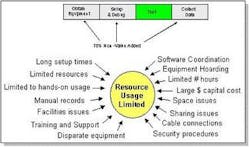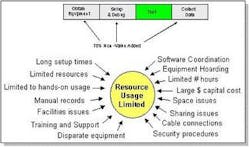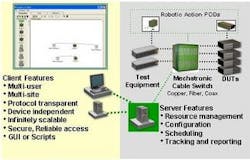Transforming in-house test labs from cost centers to competitive advantage
Automated lab facilities improve "time to quality" as well as a company's bottom line.
Marc Hornbeek
EdenTree Technologies
Despite the tighter budgets and dwindling manpower in today's large and small companies, verification and test laboratories still represent a major manpower and equipment investment as a vital part of any organization. With this in mind, one would expect these laboratories to operate logically and efficiently to provide a reasonable return-on-investment (ROI) for the business. In many cases, however, labs are more often a "rat's nest" of equipment and connections -- riddled with inefficiencies, redundancies, and limited or non-existent remote capabilities (Figure 1).
As these inefficiencies become more evident and costly, many companies are seeking a new approach that will streamline operations, provide a competitive advantage, and provide more ROI potential. The solution is an automated lab infrastructure system that enables efficient use of human resources, better control and auditability of equipment, and remote lab management. Such a system results in faster time-to-quality performance and makes "doing more with less" a cost-saving reality.
Costly inefficiencies
In today's labs, particularly optical equipment labs, there is substantial human interaction -- connecting cables, reconfiguring hardware, and operating test equipment. Managing all the cables and equipment takes time. For example, just moving a fiber cable from one connection to another requires cleaning the ends of the fiber to ensure a clear path. The effort involved, though necessary, is not a value-added effort and costs money in terms of wasted manpower and time. Typically, much of a higher-paid engineer's time is spent performing non-engineering tasks.
Equipment is rarely used efficiently if human interaction is necessary to the operation. During breaks and non-operating hours, much of the equipment lies dormant. Equipment sharing difficulties result in equipment-hoarding behaviors that promote underutilization of some equipment and even encourage a need for redundant test equipment. In many labs, much of the expensive test equipment simply lies idle for more than 60% of the time. Without an efficient method of equipment auditing, the company significantly suffers from poor utilization and rapid depreciation.
Other problems that often plague many laboratory environments include human error, time spent in setting up equipment configurations, inefficiencies in sharing and documenting test data, manual interconnection and operation of equipment, and antiquated testing methods or procedures that require human interaction at every turn.
Automated solution components
The automated lab infrastructure system was designed to attack and eliminate these laboratory inefficiencies (Figure 2). The system is based on four components -- a client/server software application, a mechatronic cable switcher, a secure and robust access protocol at the application layer, and robotic "action pods."
The client/server software is a unique architecture that enables the client to remotely access the laboratory infrastructure. The server can reside remotely from the client, enabling companies to take advantage of lower-rent facilities or shorter commutes for some employees. Typically, the server resides near the equipment and performs all management functions of the system, including tracking equipment usage and location for better auditability. A variety of additional functions can be built into the server, such as a reservation system for resolving clashes when multiple clients attempt to access shared equipment.
The mechatronic cable switcher, or cable switch, literally looks like any cable, but has a unique function. It performs the same function of the human operating the patch cord for connecting wires to various pieces of equipment. The cable switch does not manipulate the signal -- there is no protocol conversion, either electrically or optically. Simply put, it's an automated patch cord driven from the client/server software that mechanically performs all patch cord switching functions.
For optical manufacturers, the cost savings of using "mechatronic" (the integration of mechanics with electronics and intelligent computer control) switching over any of the alternative switching approaches can be huge. Micro-electro-mechanical systems (MEMS) and photonics-based switching are an order of magnitude more expensive per port than mechatronic switching.
A distinctive access protocol drives the mechatronic cable switcher and operates between the client and the server. The access protocol is designed for extreme reliability and security. Security has recently become more of an issue for the laboratory environment, particularly when operations are performed remotely. The entire automated lab architecture is based around this access protocol for driving the hardware and interacting between the software components.
The fourth component incorporates robotics into the system to perform various physical tasks. Complete automation of routine lab operations involves much more than simply automating the patch panel. Traditionally, people are necessary to perform functions such as pushing a particular reset button, checking an LED to see if it's red or green, or flicking on a power switch. There are almost a limitless number of simple functions that can easily be automated to eliminate the need for human interaction -- not to mention eliminating the chance for human error. Action pods can be programmed and remotely managed to perform nearly any routine or repetitive function associated with laboratory testing operations.
Any type of interface card -- fiber, copper, or coaxial -- can be combined in one chassis. The slots are universal, enabling mixing and matching for any niche application. For optical environments, the mechatronic switcher is purely a physical layer -- literally moving a cable between ports mechanically -- making it protocol agnostic. Any port can support any type of fiber or connector and can be changed day to day or even hour to hour. Transceivers aren't needed because the signal is not being converted or manipulated in any way -- the light simply passes through. Having "any mode" compatibility without major system configuration provides a big benefit for the convergence audience.
Meeting today's challenges
From a management point of view, the automated lab infrastructure system provides better use of human resources, saving time and money in terms of labor. Better auditability and more efficient use of equipment resources are also key benefits. The system can also automatically recall configurations that have been performed in the past and reconfigure in much less time. Automated equipment reconfiguration can reduce redundant equipment requirements and enable labs to reuse equipment in a number of different configurations -- all recallable according to the function required.
Having an automated verification and test lab that can be managed, switched, reserved, monitored, and controlled securely from any location using the same graphical user interface will provide any company with at least one competitive advantage -- faster time to quality. In these days of economic hardship and intense competition, increasing productivity without increasing costs can be an uphill battle for any company. A streamlined laboratory environment, outfitted with a labor-saving and efficiency-boosting automated operating system, will help companies meet the productivity challenge.
Marc Hornbeek is the primary founder and chief technical officer of EdenTree Technologies (Camarillo, CA); www.edentreetech.com. He has over 25 years experience in the communications and networking industry. He holds a B.Sc. EE from Queen's University and an EMBA from Pepperdine University.

